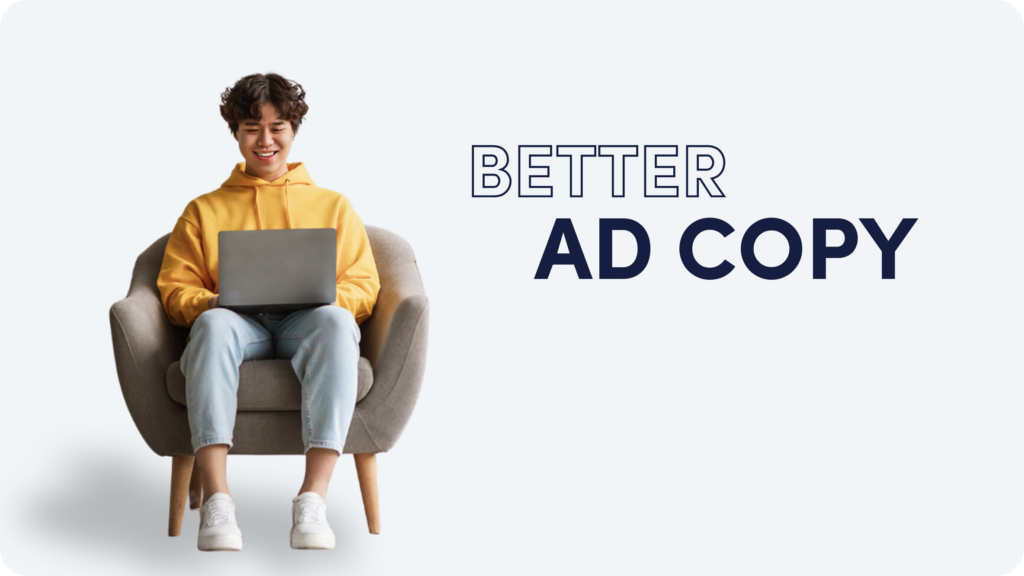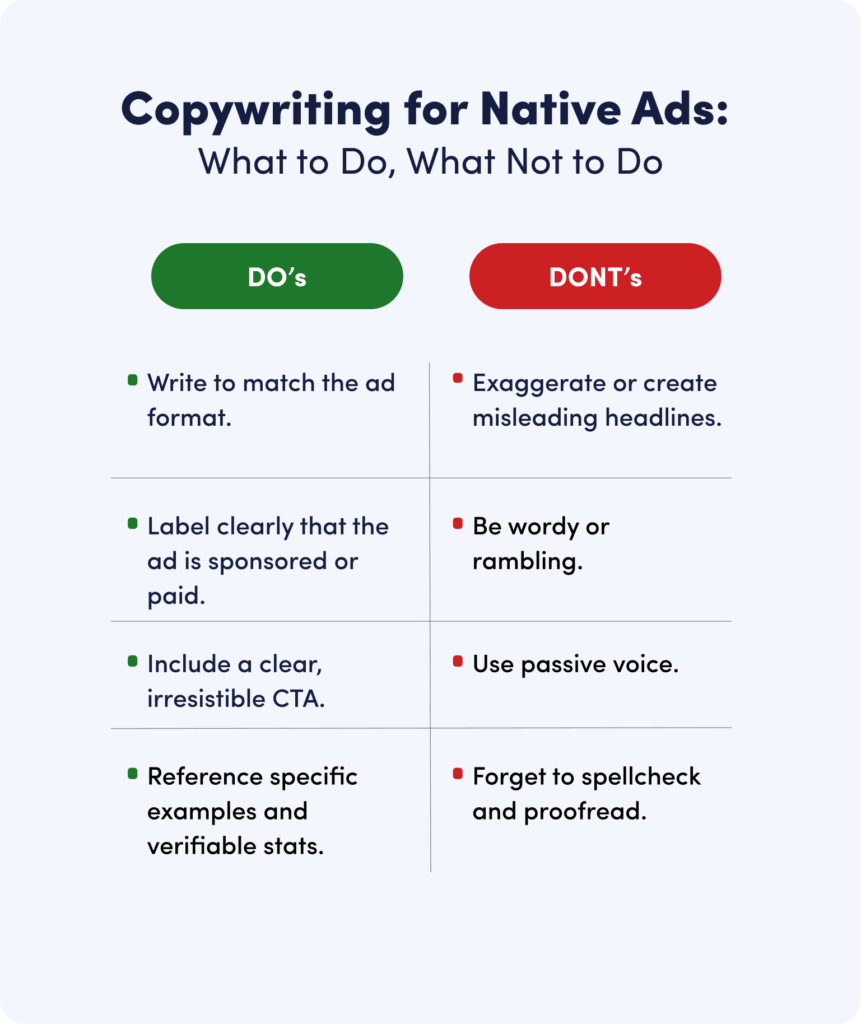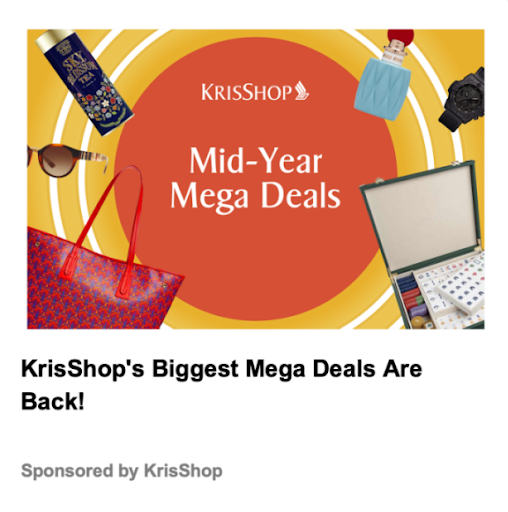How to Write Effective Copy for Native Ads

Not all digital ads are equal. Native advertising is a breed of its own, and there are key differences in how to write native ad copy versus other ad types.
Why is that? Because native ads work differently than display ads or pop-ups.
Native ads fit in with the form and function of the web page they appear on, so they often don’t seem like ads. Whereas banners and pop-ups may feel intrusive to readers, native ads flow more naturally with the surrounding editorial content.
In essence, native ads are a soft-sell advertising technique that aims to nurture the viewer and gently coax them to click on the ad and interact with the brand’s advertorial content or landing page.
But how can you achieve this effect and write ad copy that draws the audience to engage with your native campaigns?
Check out the following “dos and don’ts” for how to write copy for native ads, and you’ll soon start to see an uplift in your native advertising success.
Native Ad Copy: Dos & Dont’s

Do: Write for your ad format.
Native advertising isn’t a one-size-fits-all deal. There are several native ad formats, ranging from standard native ads to sophisticated native video ads.
The main types of native ads include:
- Content recommendations
- In-feed ads
- Paid search units
- Search and promoted listings
- Native video
- Native carousel ads
- Custom ads that do not belong in any of the previous categories
Given this variety, copywriting should match the specific ad specs, and work in the context of the ad type to provide a compelling and coherent viewer experience.
For example, the Outbrain native ad format for promoting app downloads supports a title of up to 100 characters, and the goal of the title should be to entice the customer to download the app. The Outbrain Click-to-Watch format only has room for a shorter 60-character title, and should provide a compelling hook to encourage the audience to click and watch the video.
With that in mind, your copywriting should always suit the format of your ad and the user experience you want to create.
Don’t: Exaggerate or use misleading headlines.
Have you ever been disappointed by an ad that promised more than it delivered? Clickbait titles may be eye-grabbing, but ultimately do more harm than good by falsely depicting the content of a landing page.
These include overly sensational headlines like “The Number One Secret for Preventing Wrinkles.”
You don’t want to trick your readers, and hyperbolic headlines will annoy them more than entice them. Moreover, these kinds of titles damage content integrity, making your site less trustworthy and dissuading potential customers from returning.
Do: Be transparent with your labeling.
Although native ads are meant to blend in with the web page’s editorial content, the Federal Trade Commission maintains that disclosure is necessary to protect against customer deception.
This means that native ads must be labeled as such. This transparency helps readers distinguish between paid and organic content, which is crucial for maintaining a positive relationship with consumers.
Additionally, Outbrain’s advertiser guidelines require you to disclose the brand name/source URL for the landing page in the ad itself. This way, advertisers are providing honest and transparent campaign information even before the user clicks on the ad. Nearly 1 in 10 people say that being able to trust a brand has become more important; you can help build that trust by clearly and accurately labeling your native ads.
Don’t: Be wordy.
Brevity is your best friend when it comes to writing native ad copy. Native ad networks have character limits for ad titles, so you need to fit in with those. In any event, users tend to scan web content rather than diligently read it, so short, snappy headlines are the way to go.
Remember, thousands of brands are simultaneously competing for your audience’s attention online. And when it comes to headlines, excess length will simply get cut off in the native ad when it goes live.
As such, your copy should be concise and to the point. Focus on providing the most value for your readers in the shortest copy possible within the defined character limits of the platform and ad format.
Take a look at the native ad copy below by KrisShop, Singapore Airlines’ on-flight and online retailer. As part of a retargeting campaign on Outbrain, the native ad was served to users who had previously visited KrisShop’s website but not yet converted. With simple, clear, yet powerful ad copy, together with smart bidding strategies targeting the most relevant, high-potential audience, KrisShop was able to triple online sales in one month with Outbrain.

Here are some quick tips for how to get more for less in your native ad headline copy:
- Use numbers. They take less space and draw the user’s attention.
- Ask a question. This is an effective way to pique the audience’s curiosity and get them thinking.
- Use personalization. Include localized data in your ad headline, such as the city name. This changes automatically according to the region of the user.
- Be negative. Sometimes, a negative rather than positive approach can make a headline more enticing. For example, instead of “How to Make Your Skin Glow This Winter”, you could try “How to Avoid Dry Skin This Winter”. Test out negative titles and see how they perform.
- Use an AI title generator. Outbrain’s built-in AI Title Generator tool creates effective title options automatically, so you can test more headlines faster.
Do: Include a clear CTA.
The CTA (call-to-action) is a critical part of your native ad ‘puzzle’. The CTA explains to the viewer what to do next: watch a video, download an app, read more, explore a product, or any other next step they should take.
The CTA is only two to three words long. There’s not a lot of room to move, which makes it even harder to do it right and stand out among the crowd.
Sometimes, you’ll naturally opt for a standard CTA, like “Learn more”. But whenever possible, test different options and try to add a creative spin. For example, “Discover the Secret”, “Upgrade Now”, or “Say Goodbye to [a problem]” are all ways you can spice up the CTAs of your native ads.
Don’t: Use passive voice.
Keep your passive voice to a minimum in your native ad copy. Though passive voice isn’t technically wrong, active voice delivers more captivating and engaging writing.
Consider these popular advertising slogans and how weak (and unusual) they sound when written in passive voice:
- McDonald’s: “I’m lovin’ it!” (active) → “It is being loved!” (passive)
- Red Bull: “It gives you wings!” (active) → “You are given wings!” (passive)
For inspiration, check out Buffer’s list of words that drive conversion, many of which are action verbs. Using active voice will not only liven your native advertising copy but will also help increase conversion rates.
Do: Use stats and specific examples.
A captivating native ad headline may attract your audience’s attention, but to get people to click, it must also be persuasive.
Make your native ad titles more compelling and authoritative by including statistics, figures, or testimonials about how your product or service is worth the purchase. For example, “200 Store Managers Swear by This Tool” is a persuasive way to ‘sell’ a product or idea.
Remember, always be truthful; you must be able to back up your claims if you want your ad to have an authentic feel and a real leg to stand on.
Don’t: Forget to proofread and spell check.
This major “don’t” is overlooked more than it should be. Run your native ad copy and landing page content through spellcheck or a second pair of eyes. This will ensure there are no misspellings or grammatical errors, and that the ad copy matches the landing page content after the viewer clicks through.
In fact, in a study by the communications firm Global Lingo, 59% of those surveyed said they’d reconsider purchasing from a website if it was error-riddled. Consequently, though a typo in a native ad headline or advertorial may seem like a minor offense, it has a strong impact on the impression your business makes on the target audience.
After the Click, What’s Next?
If you’ve written great native ad copy, then you are more likely to get clicks on your ad.
After the user clicks through, they will land on your content page, whether it’s a landing page, advertorial page, product page, or perhaps a blog.
That’s when the next phase of your native advertising campaign kicks in: engaging the reader with your content, and getting them to take the action to convert. That may be purchasing a product, signing up for a webinar, or requesting a meeting. Whatever your goal, creating high-converting content for your native campaigns is the key to achieving it.
Want to put these native ad copywriting tips into practice in your Outbrain campaign?


